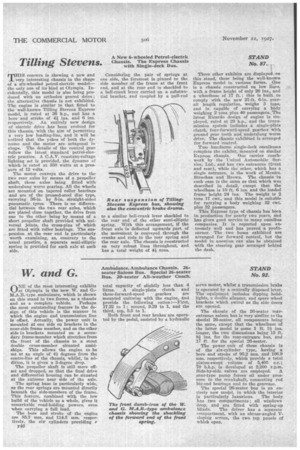Tilling Stevens.
Page 170

If you've noticed an error in this article please click here to report it so we can fix it.
THIS concern is showing a new and very interesting chassis in the shape of a six-wheeled petrol-electric model— the only one of its kind at Olympia. Incidentally, this model is also being produced with an orthodox geared drive ; the alternative chassis is not exhibited. The engine is similar to that fitted to the well-known Tilling Stevens Express model, is rated at 36 h.p., and has a bore and stroke of 41 ins. and 6 ins. respectively. An entirely new design of electric drive has been evolved for this chassis, with the aim of permitting a very low loading-line, and it will be noticed that the yokes of both the dynamo and the motor are octagonal in shape. The details of the control gear follow the latest standard petrol-electric practice. A C.A.V. constant-voltage lighting set is provided, the dynamo of which is rated at 350 watts at a pressure of 12 volts.
The motor conveys the drive to the two rear axles by means of a propeller shaft, these axles being fitted with underslung worm gearing. All the wheels are mounted on tapered roller bearings and are of the pressed-steel disc type, carrying 36-in. by 8-in, straight-sided pneumatic tyres. There is no differential between the two rear axles, which are placed close together, the drive from one to the other being by means of a short propeller shaft provided with universal joints, the cross-pins of which are fitted with roller bearings. The suspension at the rear end is particularly worth examining, as, contrary to the usual practice, a separate semi-elliptic spring is provided for each axle at each side.
Consideiing the pair of springs at one side, the foremost is pinned to the side member of the frame at the front end, and at the rear end is shackled to a bell-crank lever carried on a substantial bracket, and coupled by a pull-rod to a similar bell-crank lever shackled to the rear end of the other semi-elliptic spring. With this arrangement, if the front axle is deflected upwards part of the movement is conveyed through the cranks and rods to the rear spring and the rear axle. The chassis is constructed On very robust lines throughout, and has a total weight of 4/ tons. Three other exhibits are displayed, on this stand, these being the well-known Express model in various forms. One is a chassis constructed on low lines, with a frame height of only 26 ins., and a wheelbase of 17 ft.; this is built to comply with the new 27-ft. 6-in. overall length regulation, weighs 3 tons, and is capable of carrying a bOdy weighing 2 tons plus 40 passengers. The latest Ricardo design of engine is employed, rated at 29 h.p., and the transmission system includes a single-plate clutch, four-forward-speed gearbox With ground gear teeth and underslung worm drive. The chassis exhibited is arranged for forward control.
Two handsome single-deck omnibuses complete the exhibit, mounted on similar
Express chassis. One carries coachwork by the United Automobile Service, Ltd., and has two entrances (front and rear), while the other, which has a single entrance, is the work of Messrs. Strachan and Brown. The chassis in each case is the same as that which was described in detail, except that the wheelbase is 15 ft. 6 ins, and the loaded frame height 24 ins. The weight is 2 tons 17 cwt., and this model is suitable for carrying a body weighing 32 cwt. plus 32 passengers.
This Express type of chassis has been in production for nearly two years, and has given good service to many omnibus companies. It is reported upon extremely well and has proved a profitearner. The two buses exhibited are arranged for forward control, but the model in question can also be obtained with the steering gear arranged behind the dash.


















































































































































































































































































































